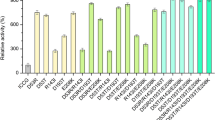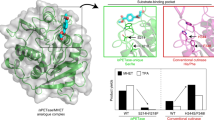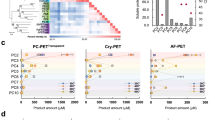Abstract
Polyethylene terephthalate (PET) is one of the most abundant polyester materials used in daily life and it is also one of the culprits of environmental pollution. ICCG (F243I/D238C/S283C/Y127G) is a quadruple mutant of leaf-branch compost cutinase (LCC) displaying outstanding performance in hydrolyzing PET and holding a great potential in further applications. Substrate concentration is one of the important factors affecting the catalytic degradation efficiency. The conventional fast equilibrium theory holds that the degradation rate reaches the maximum and tends to be stable with the increase of substrate concentration, however, in practice, too much substrate will inhibit the catalytic reaction. In this study, the substrate inhibitory effect of PET plastic particles with different particle sizes on ICCG was evaluated. Combined with kinetic constant analysis, the optimal PET particle size was determined to be 300 μm. Meanwhile, several mutants (Y95K, M166S and H218S) of ICCG were obtained by site-directed mutagenesis. The effect of substrate concentration on mutant was studied under the condition of optimal reaction particle size. This study provides a strategy for obtaining high-efficiency PET degradation mutants and a new possibility of environmentally friendly plastic degradation.





Similar content being viewed by others
REFERENCES
Zhang, K., Hamidian, A. H., Tubic, A., Zhang, Yu., Fang, J.K.H., Wu, C., et al., Environ. Pollut., 2021, vol. 274, p. 116554. https://doi.org/10.1016/j.envpol.2021.116554
Urbanek, A.K., Rymowicz, W., Mironczuk, A.M., Appl. Microbiol. Biotechnol., 2018, vol. 102, no. 18, pp. 7669–7877. https://doi.org/10.1007/s00253-018-9195-y
Nakamura, S., Environ. Sci. Technol., 2020, vol. 54, pp. 14862–14867. https://doi.org/10.1021/acs.est.0c06015
Austin, H.P., Allen, M.D., Donohoe, B.S., Rorrer, N. A., Kearns, F.L., Silveira, R. L., et al., Proc. Natl. Acad. Sci. U. S. A., 2018, vol. 115, no. 19, pp. 4350–4357. https://doi.org/10.1073/pnas.1718804115
George, N. and Kurian T., Ind. Eng. Chem. Res., 2014, vol. 134, no. 15, pp. 1167–1177. https://doi.org/10.1021/ie501995m
Mohammadian, M., Allen, N.S., Edge, M., and Jones, K., Text. Res. J., 1991, vol. 175, no. 33, pp. 119–127. https://doi.org/10.1177/004051759106101109
Daniel, P. and Tadeusz, S., Resour. Conserv. Recycl., 1997, vol. 257, p. 432. https://doi.org/10.1016/j.resconrec.2022.106854
Liu, L., Xu, M., Ye, Y., and Zhang, B., Sci. Total Environ., 2021, vol. 15, no. 23, pp. 2274–2281. https://doi.org/10.1016/j.scitotenv.2021.151312
Singh, J. J., Bansal, S., Sonthalia, A., Rai, A.K., and Singh, S.P., Bioresour. Technol., 2022, vol. 335, no. 27, pp. 1126–1139. https://doi.org/10.1016/j.biortech.2022.126697
Wei, R., Tiso, T., Bertling, J., O’Connor, K., Blank, L.M., and Bornscheuer, U.T., Nat. Catal., 2020, vol. 447, pp. 2279–2288. https://doi.org/10.1038/s41929-020-00521-w
Shirke, A.N., White, C., Englaender, J.A., Zwarycz, A., Butterfoss, G.L., Linhardt, R.J., et al., Biochemistry, 2018, vol. 129, pp. 7432–7437. https://doi.org/10.1021/acs.biochem.7b01189
Ribitsch, D., Hromic, A., Zitzenbacher, S., Zartl, B., Gamerith, C., Pellis, A., et al., Biotechnol. Bioeng., 2017, vol. 39, no. 47, pp. 749–758. https://doi.org/10.1002/bit.26372
Čorak, I., Tarbuk, A., Đorđević, D., Višić, K., and Botteri, L, Materials, 2022, vol. 64, no. 27, pp. 2556–2559. https://doi.org/10.3390/ma15041530
Yoshida, S., Hiraga, K., Takehana, T., Taniguchi, I., Yamaji, H., Maeda, Y., et al., Science, 2016, vol. 189, no. 13, pp. 177–179. https://doi.org/10.1126/science.aad6359
Tournier, V., Topham, C.M., Gilles, A., David, B., Folgoas, C., Moya-Leclair, E., et al., Nature, 2020, vol. 580, no. 7802, pp. 216–219. https://doi.org/10.1038/s41586-020-2149-4
Mariñas-Collado, I., Rivas-López, M.J., Rodríguez-Díaz, J.M., and Santos-Martín, M.T., Chemom. Intell. Lab. Syst., 2019, vol. 189, pp. 102–109. https://doi.org/10.1016/j.chemolab.2019.04.005
Khrenova., M.G., Polyakov., I.V., and Nemukhin A.V., Russ. J. Phys. Chem. B., 2022, vol. 188, no. 19, pp. 127–132. https://doi.org/10.1134/s1990793122030174
Han, X., Liu, W., Huang, J.-W., Ma, J., Zheng, Y., Ko, T-P., et al., Nat. Commun., 2017, vol. 226, pp. 507–511. https://doi.org/10.1038/s41467-017-02255-z
Miles, S.A., Science, 1951, vol. 13, pp. 155–159. https://doi.org/10.1126/science.114.2969.554-a
Walters, D.E., J. Med. Chem., 2002, vol. 17, no. 33, pp. 751–755. https://doi.org/10.1021/jm020467f
Kaiser, P.M., J. Mol. Catal., 1980, vol. 8, no 4, pp. 431–442. https://doi.org/10.1016/0304-5102(80)80082-4
Gente, V., La Marca, F., Lucci, F., Massacci, P., and Pani, E., Waste Manage., 2004, vol. 11, no. 3, pp. 451–454. https://doi.org/10.1016/j.wasman.2004.03.005
Yang, K., Sun, W., Li, Q., Wang, J., Yao, J., and Wang, X., Anal. Sci., 2022, vol. 226, p. 7443. https://doi.org/10.1007/s44211-022-00091-w
Barth, M., Oeser, T., Wei, R., Then, J., Schmidt, J., and Zimmermann, W., Biochem. Eng. J., 2015, vol. 93, pp. 222–228. https://doi.org/10.1016/j.bej.2014.10.012
Arnling B.J., Borch K., and Westh P., Anal. Biochem., 2020, vol. 607, p. 113873. https://doi.org/10.1016/j.ab.2020.113873
Yoshino, M. and Murakami, K., SpringerPlus, 2015, vol. 4, pp. 292–294. https://doi.org/10.1186/s40064-015-1082-8
Kaiser, P.M., J. Mol. Catal., 1980, vol. 8, no. 3, pp. 2551–2556. https://doi.org/10.1016/0304-5102(80)80082-4
Kühl, P.W., Biochem. J., 1994, vol. 1, no. 1, pp. 171–180. https://doi.org/10.1042/bj2980171
Liu, Y., Liu, Z., Guo, Z., Yan, T., Jin, C., and Wu, J., Sci. Total Environ., 2022, vol. 834, p. 154947. https://doi.org/10.1016/j.scitotenv.2022.154947
Zeng, W., Li, X., Yang, Y., Min, J., Huang, J-W., and Liu, W., ACS Catal., 2022, vol. 12, no. 5, pp. 3033–3040. https://doi.org/10.1021/acscatal.1c05800
Chen, C-C., Han, X., Li, X., Jiang, P., Niu, D., Ma, L., et al., Nat. Catal., 2021, vol. 4, no. 5, pp. 425–430. https://doi.org/10.1038/s41929-021-00616-y
Joo, S., Cho, I.J., Seo, H., Son, H.F., Sagong, H-Y., Shin, T.J., Choi, S.Y., et al., Nat. Commun., 2018, vol. 9, no. 1, p. 382. https://doi.org/10.1038/s41467-018-02881-1
Lu, H., Diaz, D.J., Czarnecki, N.J., Zhu, C., Kim, W., Shroff, R., et al., Nature, 2022, vol. 604, no. 7907, pp. 662–667. https://doi.org/10.1038/s41586-022-04599-z
Funding
The study was financially supported by the National Natural Science Foundation of China (Grant no. 22273032 to J.Y.) and the Shandong Provincial Natural Science Foundation of China (Grants ZR2022MC046 to J.Y. and Grants ZR2022MB138 to X.W.).
Author information
Authors and Affiliations
Corresponding authors
Ethics declarations
ETHICS APPROVAL AND CONSENT TO PARTICIPATE
This work does not contain any studies involving human and animal subjects.
CONFLICT OF INTEREST
The authors of this work declare that they have no conflicts of interest.
Additional information
Publisher’s Note.
Pleiades Publishing remains neutral with regard to jurisdictional claims in published maps and institutional affiliations.
Supplementary Information
Rights and permissions
About this article
Cite this article
Li, Q., Jing, N., Leng, X. et al. Substrate Inhibition of the Highly Efficient PET Hydrolase. Appl Biochem Microbiol 60, 280–286 (2024). https://doi.org/10.1134/S0003683824020091
Received:
Revised:
Accepted:
Published:
Issue Date:
DOI: https://doi.org/10.1134/S0003683824020091




